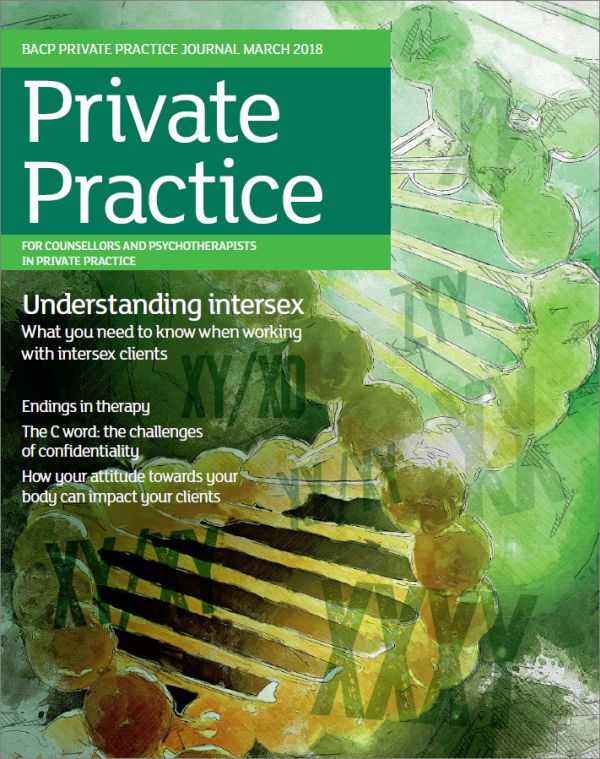In this issue
Features
The C word
Janet Watson reflects on the challenges of maintaining confidentiality
Tragic optimism (free article)
Christopher Tovey explains why existential theory has helped him on his path towards authenticity
The sense of an ending
Rebecca Mitchell on how endings in therapy can evoke painful feelings in both therapist and client
Understanding intersex (free article)
Jane Czyzselska explains what therapists need to know when working with intersex clients
Working with the body
Alison Sharman on the ways in which a counsellor’s own body image might impact on client work
Regulars
From the chair
Mervyn Wynne Jones: Innocents abroad
My practice
Sarah Van Gogh: Slow, slow, quick, quick, slow
Supervision
Jim Holloway: What do your clients say about you?
Business matters
Martin Hogg: A question of focus
Relationships
Alex Sanderson-Shortt: Love less ordinary

A pdf of this issue is available in the Private Practice archive
Welcome from the editor
While issues relating to transgender and non-binary gender identities have become a focus of media attention in recent years, the biological variance known as intersex is far less discussed and understood, despite the fact that there is a significant UK population of approximately 358,105 people with intersex variations.1
Lamentably, this includes a lack of discussion in psychotherapeutic literature and training curricula. I’m delighted, therefore, that our cover feature by Jane Czyzselska, based on research for her master’s in integrative psychotherapy, examines the experiences in therapy of clients born with intersex characteristics. Reflecting the lack of intersex visibility in the wider society, perhaps unsurprisingly, Jane found that almost all therapists seen by the research participants knew nothing about intersex lives and experiences.
To remedy this, Jane explains what therapists need to know when working with intersex clients, and advises those who aren’t themselves intersex to be reflexive about their own relationship with their gendered physiologies before intervening in the lives of those who are. She also argues that therapists who are psychologically invested in their own normative bodies, and challenged by bodies that don’t fit into normative rules, risk enforcing a binary gender on intersex people.
In a separate article with a theme that links to this point, Alison Sharman writes about the unconscious, unspoken impact that a therapist’s relationship with their own body can have on clients. As with the topic of intersex, there is little in the psychotherapy literature that addresses the therapist’s body. When the body is written about, the focus of attention is mostly on the client’s body, with the therapist’s seen as merely a receptacle for transferential phenomena.
As Alison acknowledges, many people have a troubled and complex relationship with their body, including therapists. Reflecting on her own journey to heal and reclaim her bodily integrity and confidence, she argues the importance for all therapists to be in touch with their own internal body states and at ease with their bodies, in order to be as fully present as possible in their work with clients. ‘Through learning to increase my body confidence,’ she writes, ‘I have better body awareness, which in turn has been immensely helpful with picking up on elusive and unnamed bodily messages that my clients communicate non-verbally.’
The theme of working with clients who are marginalised or stigmatised by social norms is picked up again by Christopher Tovey in an article on existential therapy. He refers to Mick Cooper’s assertion that therapists with an existential approach may be seen as anarchists within the profession because they invite clients to question the world around them and live their lives as they see fit. It’s easy to see, therefore, how an existential approach might benefit an intersex client, for example, as the focus isn’t on what’s wrong with the client, but on the client’s experience of confronting a world that may oppress, objectify and discriminate against them. As Christopher writes, ‘Engaging with clients in such a depathologising way may be experienced as profoundly helpful, validating and empowering.’
Furthermore, an existential standpoint invites us to consider social activism as a means towards improved psychological wellbeing. As Christopher writes, therapists may consider this outside their remit, but in a world where some clients are stigmatised, discriminated against and repressed, there may be only so much that individual therapeutic work can do to help such people feel and function better. Instead, for example, laws may need to be changed and stereotypes campaigned against.
Elsewhere in this issue, in addition to our regular columnists and book reviews, you will find articles on two omnipresent areas of clinical practice – confidentiality and endings – and the challenges these can pose for therapists in private practice. Janet Watson highlights the isolation of working alone, without daily contact with peers, and the strain this can place on us. ‘Often, after a “bad day” in the counselling room,’ she writes, ‘my partner senses my distress and asks how things have gone. I have a stock answer: “Oh, you know. Talked to some sad people…”’
And the strain of maintaining confidentiality – notwithstanding the space that supervision of course allows for personal and professional support – doesn’t only affect us when we are struggling to contain our clients’ suffering, it also inhibits us from sharing and celebrating our joy when there are positive outcomes to the therapy.
In her article about endings, quoting from Carl Bard, Rebecca Mitchell ends on a hopeful note, pointing out that while our past is unalterable, we can empower ourselves to have a different future: ‘Though no one can go back and make a brand new start, anyone can start from now and make a brand new ending.’2
The theme of endings brings me neatly on to this year’s BACP Private Practice annual conference on the theme of loss. See the Conference webpage for the latest details and how to book.
John Daniel
Editor
privatepractice.editorial@bacp.co.uk
References
1. Czyzselska J. Invisible communities: hidden realities of intersex people in therapy, and sensitive ways of working with this client group; an Interpretative Phenomenological Analysis. Unpublished MA dissertation; 2016.
2. Bard C. [Online.] https://tinybuddha.com/wisdom- quotes/though-no-one-can-go-back-and-make-a- brand-new-start-anyone-can-start-from-now-and- make-a-brand-new-ending/ (accessed 3 February 2018).
